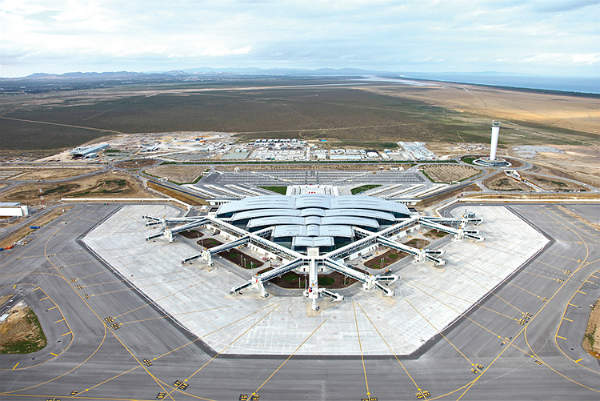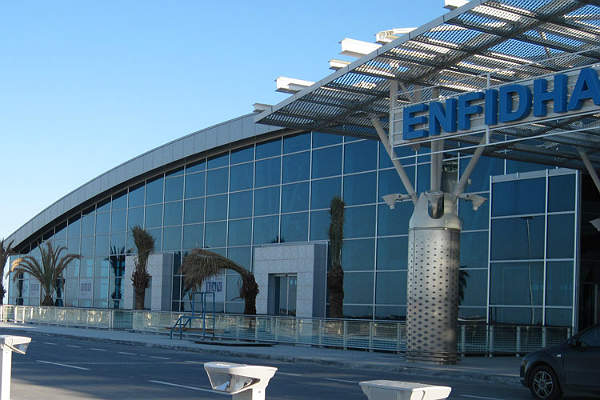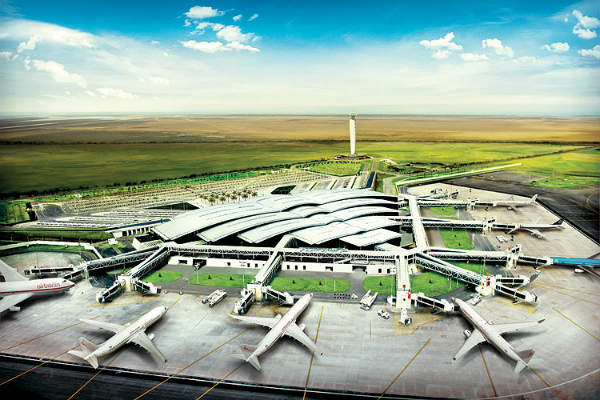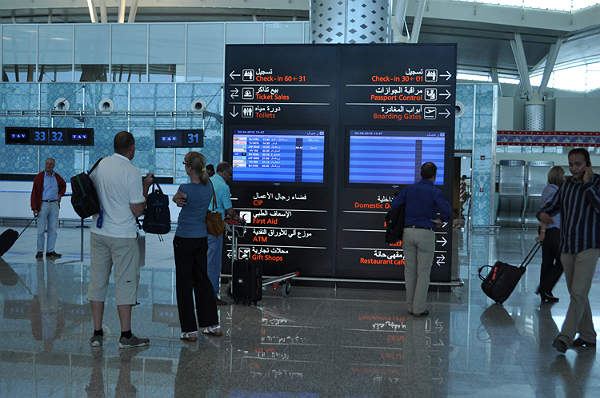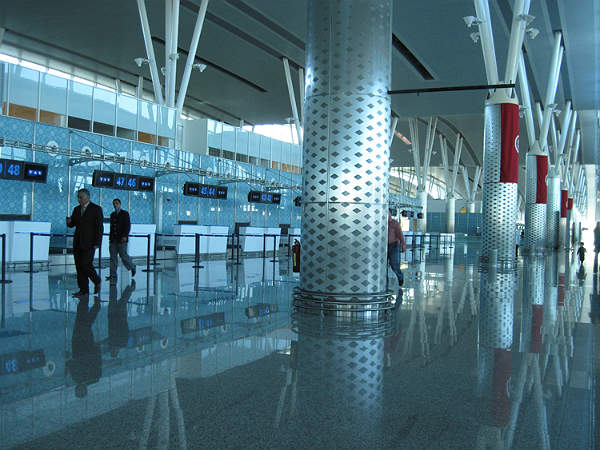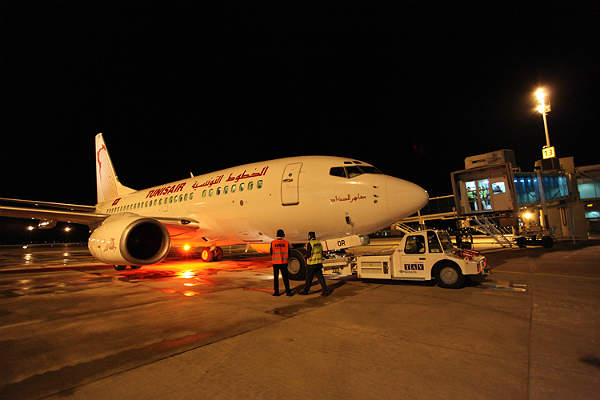Tunisia is a country which has promoted its assets well. It has developed facilities for tourism and is now one of the premier destinations in Africa for travelling Europeans, with year-round sunshine, excellent hotels and beaches, fine golf courses and first-class service.
The country contains a large proportion of the Sahara Desert but even this is an asset to tourism.
Tunisia may be reached by travelling to one of the nine international airports around the country: Tunis-Carthage (eight kilometres from the capital Tunis), DJerba-Zarzis Airport, Gabès-Matmata Airport, Gafsa-Ksar Airport, Monastir Habib Bourguiba Airport, Sfax-Thyna Airport, Tozeur-Nefta Airport or Tabarka-Ain Draham Airport, as well as the newly built Enfidha-Hammamet Airport. All of these airports are fairly small, with limited facilities for the sophisticated air traveller.
In 2004, the Tunisian Government decided to build the Enfidha-Hammamet Airport on a 6,500ha site at Enfidha – a state-of-the-art international airport complex with first-class shopping, restaurants, entertainment facilities and services for the airlines and passengers.
More importantly, the airport was to be situated at Enfidha, in the north-east of the country, about 80km south of the capital Tunis but in the middle of a major tourist region.
The planning and design had been completed by 2001 but unfortunately due to a combination of circumstances, including a breakdown in negotiations over the terms of building the airport, problems in raising the funding and political manoeuvring, the airport was never built and the project was shelved.
Revival of Tunisia’s international airport project
During 2005 and 2006 the project was revived by the Tunisian Government, which was eager to complete the new airport under a build operate transfer (BOT) basis with a 40-year concession.
The Enfidha-Hammamet International Airport was opened for operations in December 2009. Former Tunisian President Zine el-Abidine Ben Ali was keen for the project to be completed before he sought a fifth term in office after the 2009 elections. The airport was originally named after Ben Ali as the Enfidha Zine El Abidine Ben Ali International Airport. It was renamed as Enfidha-Hammamet Airport in January 2011, following the Tunisian revolution which ended his regime.
The Tunisian Government did not want the new airport to be as luxurious as originally envisaged. Demands for a costly state-of-the-art facility were seen as a discouragement to potential bidders since the airport serves mainly tourist charter flights.
The new Enfidha airport eased the passenger and goods traffic that passes through Tunis-Carthage and Monastir airports. It is conveniently located to serve the tourist regions of Yasmine Hammamet and Port El Kantaoui (near Hergla), Nabeul and Sousse, as well as the towns of Tunis, Sfax, Bizerte and Kairouan.
Construction plans and phases at Enfidha-Hammamet airport
Aéroports de Paris (ADP) completed the design of the new international airport at Enfidha in the final quarter of 2001 (in a contract worth $9.6m) and also prepared the tender documents for the contracts relating to the construction in mid-2006.
The construction plans called for building the airport in several phases; the first phase of the airport, completed in 2009, has a passenger handling capacity of seven million a year. Subsequent phases are expected to increase the capacity to ten million (2022) and then 22 million (2036) in the longer-term.
The deal offered by the Tunisian Airport Authority also included the existing airport at Monastir, 60km from the proposed Enfidha facility. Its inclusion was important as it will provide the operator with a revenue stream during construction and remove the issue of competition between the two airports.
The six pre-qualifiers for the BOT contract were: Tepe Akfen Ventures (TAV) of Turkey; Aéroports de Paris and Vinci of France; Hochtief, SNC Lavalin and Aéroport de Nice; Airports Company South Africa; Aeropuertos and Servicios Auxiliares with Inmobiliaria Fumisa of Mexico, and Corporación América Sudaméricana of Argentina.
Tepe Akfen Ventures (TAV) was selected as lead contractor for the airport. TAV Tunisie was established in May 2007 to operate the Enfidha and Monastir airports for the next 40 years as part of a €563m contract. The project received funding from Standard Bank, Lagos State and the African Development Bank.
‘Modern’ design at IATA: NBE
The main architectural theme for the airport is ‘modern’. The airport is considered a symbol of the country and reflects the image of modern Tunisia.
The terminal has been designed as a square diamond, the point of which is directed towards the landing strips. The 90,000 square metre terminal building is covered with a light roof in the shape of giant wings.
The external façade shows a clear division between lower level and upper levels. The use of glazing allows light to permeate the whole of the interior space.
A large patio has been established in the centre of the building and gardens between the runway and departure lounges offer passengers a chance to relax. The interior design is a mixture of traditional and modern styles.
The airport includes a 72,000 square metre apron area with a capacity to accommodate 18 aircraft. The remote apron area, which measures 57,000 square metres, can handle 14 aircraft. The asphalt runway 09/27 is 3,300m long and 60m wide. The total length of the taxiway is 13,000m and width is 25m. There are 18 passenger boarding bridges complete with check-in counters, baggage carousels, immigration and customs booths. The air traffic control (ATC) tower is 90m high.
Construction at Enfidha-Hammamet International Airport
Construction work began in June 2007. Wassim Ben Mahmoud was the architect. Technical studies were carried out by engineering company SCET Tunisie and engineering consultancy STUDI Group. Nexans supplied the power cables for the terminal building as part of a €2m contract.

